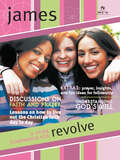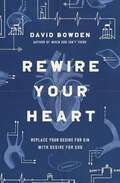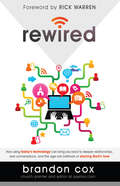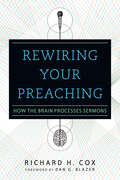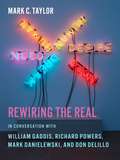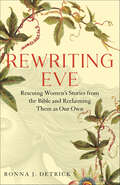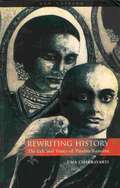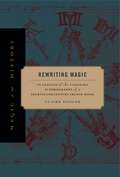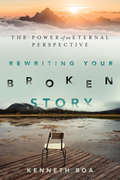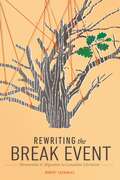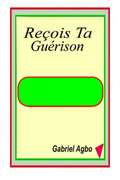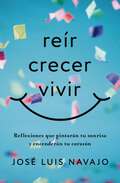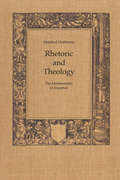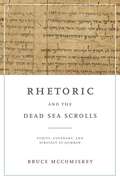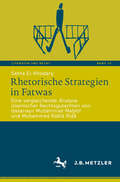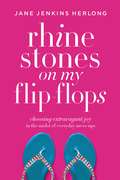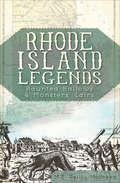- Table View
- List View
Revolve Study Guide
by Thomas NelsonThe Revolve/Refuel Study Guide Series is the coolest way for teens to study chosen books of the Bible including Mark and James. In a mini-magazine format, each guide will contain seven chapters along with sections and sidebars similar to Revolve and Refuel (NCV). Each chapter focuses on building the reader's knowledge of the Bible while nurturing an understanding of what the Bible has to say in reference to their own lives. The Revolve/Refuel Study Guide Series will not only serve teens by providing Biblical truth-- it will make studying the Bible easy, and most importantly, awesome!
Reweaving the Relational Mat: A Christian Response to Violence Against Women from Oceania (Religion and Violence)
by Joan Filemoni-Tofaeono Lydia JohnsonReweaving the Relational Mat is an integrative response to the problem of violence against women which grounds theological and sociological analysis in the praxis of Oceanian Christian women's experiences of violence. It focuses on the collusion of the church in the problem of violence against women by critiquing the ways in which its theology and practices have contributed to 'power-over' ways of relating. Employing the Oceanian metaphor of weaving the mat, the analysis 'unravels' the 'patriarchal relational mat,' paving the way for a constructive 'reweaving' of a Christocentric 'egalitarian relational mat.' The study begins by unravelling the correlation between violence and the ideology of patriarchy. It then highlights the various strands of violence against women, and examines the complex mosaic of socio-cultural sources and manifestations of violence against women in Oceania. This leads to an analysis of the interwoven strands of religion and violence, focusing particularly on the church's captivity to patriarchy. The ensuing explication of problematic theological and biblical interpretations and church practices ends with a critique of male clergy power, particularly as it functions in the Oceanian context. This leads to an examination of the relationship between flawed theological education and violence against women. Case studies of violence against women in the Oceanian theological education setting are analysed. The subsequent 'reweaving of the relational mat' issues forth in specific challenges to church leaders, theological educators and church women.
Rewire Your Heart: Replace Your Desire for Sin with Desire For God
by David BowdenBible teacher and acclaimed spoken-word artist David Bowden reveals the secret to winning the battle with sin.Many Christians believe the only way to fight sin is to grit our teeth, strengthen our resolve, and rise above the onslaught of temptation. But in reality, we have a far better weapon in our struggle with sin than the will-power mantras associated with diet and exercise. This weapon is not saying "no" to sin but saying "yes" to God. In Rewire Your Heart, David Bowden helps us discover God's plan to overcoming sin by rewiring our desires with the Gospel. When we invite the Holy Spirit to transform our underlying affections with the good news of Jesus, we begin to break free from the patterns of sin, guilt, and determination, and discover the richer fulfillment found in joyfully obeying God's commands.
Rewired: How Using Today's Technology Can Bring You Back to Deeper Relationships, Real Conversations, and the Age-Old Methods of Sharing God's Love
by Brandon CoxIf God’s desire to enlarge His family matters... If the church of the future matters... If the gospel still matters... We must embrace the changes that are happening in our world. There is no going back. Our world is changing at an unprecedented rate. We are connected with people all over the planet through technology that didn’t even exist ten years ago. The world around us is having a conversation about life, meaning, culture, and eternity, and we have an amazing opportunity not just to join the conversation but also to lead it. But too many in the church are struggling to keep up with this cultural shift and failing to use these communication tools to their full advantage. In Rewired Brandon Cox demonstrates the real, connecting power in online social networks, showing you how to connect and tell God’s story relationally and creatively in our social, digital age. Because the thing is, social media isn’t an escape from the real world. It is the real world, whether we are ready for it or not. And this shift we are seeing toward a more mobile, social environment is actually a return to the form we were created for: to be in relationships, to have conversations, and to share our stories--and God’s--with each other.
Rewiring Your Preaching: How the Brain Processes Sermons
by Richard H. CoxWhat preachers preach is not necessarily what hearers hear. Have you ever wondered why some hearers are affected by a sermon but not others? The issue may not necessarily be the content or delivery of the message. It may be how your hearers' brains process what you say. Modern neuroscience illuminates how our brains understand and hear sermons. Verbal stimuli can be accepted or rejected depending on the context of how they are received. The brain processes new information differently than information that reinforces already-held beliefs. To have long-term effect, new information must connect with previous memory. Psychologist, physician and preacher Richard Cox shows that better understanding of the brain can help preachers be more effective in their preaching. Intentional, purposeful preaching can actually produce new neural pathways that change how the brain thinks and how its owner acts. Our brains are intimately connected with how our bodies work, especially in how brain stimuli produce behavioral responses and how people experience comfort and healing in times of pain. God is at work in our brains to enable his people to hear him. Preach with the brain in mind, and help your hearers grow in mental, physical and spiritual health.
Rewiring the Real: In Conversation with William Gaddis, Richard Powers, Mark Danielewski, and Don DeLillo (Religion, Culture, and Public Life #12)
by Mark C. TaylorDigital and electronic technologies that act as extensions of our bodies and minds are changing how we live, think, act, and write. Some welcome these developments as bringing humans closer to unified consciousness and eternal life. Others worry that invasive globalized technologies threaten to destroy the self and the world. Whether feared or desired, these innovations provoke emotions that have long fueled the religious imagination, suggesting the presence of a latent spirituality in an era mistakenly deemed secular and posthuman.William Gaddis, Richard Powers, Mark Danielewski, and Don DeLillo are American authors who explore this phenomenon thoroughly in their work. Engaging the works of each in conversation, Mark C. Taylor discusses their sophisticated representations of new media, communications, information, and virtual technologies and their transformative effects on the self and society. He focuses on Gaddis's The Recognitions, Powers's Plowing the Dark, Danielewski's House of Leaves, and DeLillo's Underworld, following the interplay of technology and religion in their narratives and their imagining of the transition from human to posthuman states. Their challenging ideas and inventive styles reveal the fascinating ways religious interests affect emerging technologies and how, in turn, these technologies guide spiritual aspirations. To read these novels from this perspective is to see them and the world anew.
Rewriting Eve: Rescuing Women's Stories from the Bible and Reclaiming Them As Our Own
by Ronna J. DetrickWe wouldn’t consider letting Isis, Medusa, Pandora, or Persephone slip from our lexicon. To somehow forget the legend of Harriet Tubman, Anne Frank, or Mother Teresa would never cross our minds. And yet when it comes to the stories of Eve and other biblical characters, they are rarely known, barely appreciated, and ostensibly “lost” by most of us not deeply entwined within organized religion. Trapped in patriarchy and theological argument, dismissed as irrelevant, or viewed as unchangeable even as times change, these women’s voices, desires, and hearts have too often been silenced through misunderstanding and neglect. As result, we are as well. But when they are reimagined, deconstructed, disentangled from doctrine and dogma, and heard on their own terms, these stories become powerful inspiration and a source of discernment that reconnects us to a feminine lineage and a sovereign sense of self we’ve never known to call on or trust. In Rewriting Eve: Rescuing Women's Stories from the Bible and Reclaiming Them As Our Own Ronna Detrick invites us into the presence and power of ten sacred women, revealing the endlessly relevant ways in which they speak today and showing how they can heal, embolden, and transform our stories.
Rewriting History: The Life and Times of Pandita Ramabai
by Uma ChakravartiThis book outlines the reconstitution of patriarchies in nineteenth century Maharashtra through an exploration of the life, work and times of Pandita Ramabai, one of India's earliest feminists.
Rewriting History: The Life and Times of Pandita Ramabai
by Uma ChakravartiIn this classic study of Pandita Ramabai's life, Uma Chakravarti brings to light one of the foremost thinkers of nineteenth-century India and one of its earliest feminists. A scholar and an eloquent speaker, Ramabai was no stranger to controversy. Her critique of Brahminical patriarchy was in sharp contrast to Annie Besant, who championed the cause of Hindu society. And in an act seen by contemporary Hindu society as a betrayal not only of her religion but of her nation, Ramabai - herself a high-caste Hindu widow - chose to convert to Christianity. Chakravarti's book stands out as one of the most important critiques of gender and power relations in colonial India, with particular emphasis on issues of class and caste.
Rewriting Magic: An Exegesis of the Visionary Autobiography of a Fourteenth-Century French Monk (Magic in History)
by Claire FangerIn Rewriting Magic, Claire Fanger explores a fourteenth-century text called The Flowers of Heavenly Teaching. Written by a Benedictine monk named John of Morigny, the work all but disappeared from the historical record, and it is only now coming to light again in multiple versions and copies. While John’s book largely comprises an extended set of prayers for gaining knowledge, The Flowers of Heavenly Teaching is unusual among prayer books of its time because it includes a visionary autobiography with intimate information about the book’s inspiration and composition. Through the window of this record, we witness how John reconstructs and reconsecrates a condemned liturgy for knowledge acquisition: the ars notoria of Solomon. John’s work was the subject of intense criticism and public scandal, and his book was burned as heretical in 1323. The trauma of these experiences left its imprint on the book, but in unexpected and sometimes baffling ways. Fanger decodes this imprint even as she relays the narrative of how she learned to understand it. In engaging prose, she explores the twin processes of knowledge acquisition in John’s visionary autobiography and her own work of discovery as she reconstructed the background to his extraordinary book. Fanger’s approach to her subject exemplifies innovative historical inquiry, research, and methodology. Part theology, part historical anthropology, part biblio-memoir, Rewriting Magic relates a story that will have deep implications for the study of medieval life, monasticism, prayer, magic, and religion.
Rewriting Magic: An Exegesis of the Visionary Autobiography of a Fourteenth-Century French Monk (Magic in History)
by Claire FangerIn Rewriting Magic, Claire Fanger explores a fourteenth-century text called The Flowers of Heavenly Teaching. Written by a Benedictine monk named John of Morigny, the work all but disappeared from the historical record, and it is only now coming to light again in multiple versions and copies. While John’s book largely comprises an extended set of prayers for gaining knowledge, The Flowers of Heavenly Teaching is unusual among prayer books of its time because it includes a visionary autobiography with intimate information about the book’s inspiration and composition. Through the window of this record, we witness how John reconstructs and reconsecrates a condemned liturgy for knowledge acquisition: the ars notoria of Solomon. John’s work was the subject of intense criticism and public scandal, and his book was burned as heretical in 1323. The trauma of these experiences left its imprint on the book, but in unexpected and sometimes baffling ways. Fanger decodes this imprint even as she relays the narrative of how she learned to understand it. In engaging prose, she explores the twin processes of knowledge acquisition in John’s visionary autobiography and her own work of discovery as she reconstructed the background to his extraordinary book. Fanger’s approach to her subject exemplifies innovative historical inquiry, research, and methodology. Part theology, part historical anthropology, part biblio-memoir, Rewriting Magic relates a story that will have deep implications for the study of medieval life, monasticism, prayer, magic, and religion.
Rewriting Your Broken Story: The Power of an Eternal Perspective
by Kenneth BoaHow do you fix a broken story? In this fallen world, life is often not how we thought it would be. Jobs vanish, relationships crumble, health fails. How do we find the hope to persevere? We can make sense of our broken stories by seeing them in the context of a larger and greater story. Kenneth Boa shows how God can transform our lives with an eternal perspective, when we live with the end in mind. In light of eternity, our struggles are temporary and our plot twists are not fatal. We are hard-wired by God with eternity in our hearts, and that longing gives us purpose, blesses others and helps us make a lasting mark on the world. Knowing our future is crucial to living our present. When we see our stories within his greater story, we learn to live with a heavenly perspective and follow it all the way home.
Rewriting the Break Event: Mennonites and Migration in Canadian Literature
by Robert ZachariasDespite the fact that Russian Mennonites began arriving in Canada en masse in the 1870s, Mennonite Canadian literature has been marked by a compulsive retelling of the mass migration of some 20,000 Russian Mennonites to Canada following the collapse of the “Mennonite Commonwealth” in the 1920s. This privileging of a seminal dispersal within the community’s broader history reveals the ways in which the 1920s narrative has come to function as an origin story, or “break event,” for the Russian Mennonites in Canada, serving to affirm a communal identity across national and generational boundaries. Drawing on recent work in diaspora studies, Rewriting the Break Event offers a historicization of Mennonite literary studies in Canada, followed by close readings of five novels that rewrite the Mennonite break event through specific strains of emphasis, including a religious narrative, ethnic narrative, trauma narrative, and meta-narrative. The result is thoughtful and engaging exploration of the shifting contours of Mennonite collective identity, and an exciting new methodology that promises to resituate the discourse of migrant writing in Canada.
Rezar a los ángeles: Motivos de invocatión y ángeles intercesores
by Charles LessageSin que nos demos cuenta, los ángeles nos acompañan a lo largo de toda nuestra vida. ¿Quiénes son?; ¿cómo se perciben?; ¿tienen una apariencia humana?; ¿los oímos a través de voces o susurros?; ¿como podemos comunicarnos con ellos?. A través de este libro, aprenderáa entrar en contacto contodos los ángeles del cielo graciasa las oraciones, un acto único que conduce al Hombre hacia un estado de conciencia elevado. Charles Lessage es periodista y poeta. Sus investigaciones le han conducido a explorar las grandes corrientes filosóficas, poéticas y religiosas. En la actualidad trabaja en el ámbitode la meditación y la lucha contra la soledad. Es autor devarias recopilaciones y poemas.
Reçois Ta Guérison
by Gabriel AgboCe livre nous enseigne les secrets pour recevoir la guérison divine. Dieu guérit-Il encore aujourd’hui? Oui! Peut-on vivre aujourd’hui en parfaite santé? Oui! Notre Dieu est le même hier, aujourd’hui et éternellement. Attends-toi à recevoir la guérison pendant que tu lis ce livre. Ici, vous découvrirez des témoignages incroyables qui affermiront votre foi et renforceront votre confiance en Sa capacité illimitée et volonté sans faille à intervenir même dans les pires situations. Par exemple, Dieu guérit encore aujourd’hui les maladies incurables ou en phase terminale. Il ressuscite encore les morts. Avez-lu l’histoire de cet homme qui est revenu de la mort à la vie après deux jours passés à la morgue ? Aujourd’hui, si Dieu peut le faire pourquoi penses-tu que ton état actuel est sans espoir? Vous y découvrirez beaucoup d’autres témoignages incroyables. Ce livre comporte dix chapitres instructifs et puissants: Tout est Possible. La Guérison est un Droit pour Toi, L’Origine de la Maladie, La Parole de Dieu, Le Nom de Jésus, Le Saint Esprit, La Puissance de la Foi, Conserver Sa Guérison. Vous découvrirez également le rôle de la prière, de l’onction d’huile, de l’imposition des mains, de la compassion (l’amour), de l’obéissance, des anges, de la louange et l’adoration, etc, dans votre quête de la guérison et la capacité à la conserver. Ce livre est conçu pour vous aider à recevoir votre guérison à mesure que vous le parcourez ; il est très pratique.
Reír, crecer, vivir: Reflexiones que pintarán tu sonrisa y encenderán tu corazón
by José Luis NavajoReír, crecer, vivir es un viaje transformador de fe y alegría escrito por el respetado autor y pastor, José Luis Navajo. En este singular diario devocional, Navajo invita a los lectores a embarcarse en una exploración de cuarenta días de las enseñanzas de la Biblia a través de la lente de eventos reales y humorísticos dentro de la comunidad evangélica.En Reír, crecer, vivir, Navajo entrelaza magistralmente lo placentero y lo profundo, infundiendo cada reflexión diaria con humor y perspicacia espiritual. La risa diaria proporcionada por los eventos de la vida real sirve como recordatorio de que la alegría es una parte esencial de nuestro viaje espiritual. Mientras te ríes, también creces, tanto en tu comprensión de las Escrituras como en tu relación personal con Cristo.Este libro:Fomentará una reflexión personal profunda e inspirará a los lectores a aplicar la sabiduría de la Biblia en su vida diaria.Ofrecerá razones diarias para reír, proporcionando un necesario respiro de las ansiedades y cargas de la vida moderna.Facilitará que los lectores se identifiquen y se sumerjan en las narrativas con historias extraídas de eventos reales en todo el mundo.Además, el formato de este diario devocional está diseñado para que sea accesible a lectores de todas las edades, géneros y nacionalidades.Requiriendo tan solo quince minutos al día, este devocional es perfecto para personas que quizás no tienen el hábito regular de la lectura. Así que, embarquémonos en este viaje encantador y enriquecedor, y permitamos que Reír, crecer, vivir traiga alegría, sabiduría bíblica e inspire una reflexión personal profunda en nuestra vida diaria.Laughing, Growing, LivingLaughing, Growing, Living is a transformative journey of faith and joy penned by the esteemed author and Pastor, José Luis Navajo. In this unique devotional journal, Navajo invites readers to embark on a forty-day exploration of the Bible's teachings through the lens of real-life, humorous events within the evangelical community. In Laughing, Growing, Living, Navajo masterfully intertwines the playful and profound, infusing each day's reflection with humor and spiritual insight. The daily laughter provided by the real-life events serves as a reminder that joy is an essential part of one's spiritual journey. As you laugh, you also grow—both in your understanding of the Scriptures and in your personal relationship with Christ.This book:Encourage deep personal reflection and inspire readers to apply the wisdom of the Bible to their daily lives.Offers daily reasons to laugh, providing a much-needed respite from the anxieties and burdens of modern life.Make it easy for readers to identify with and immerse themselves in the narratives with stories drawn from real events worldwide.What's more, this devotional journal format is designed to be accessible to readers of all ages, genders, and nationalities.Requiring just fifteen minutes a day, this devotional is perfect for individuals who may not have a regular reading habit. So, embark on this delightful and enriching journey, and let Laughing, Growing, Living bring joy, biblical wisdom, and encourage deep personal reflection into your daily life.
Rhapsody in Black: The Life Story of John Jasper
by Richard E Day“The life and ministry of John Jasper – the extraordinary preacher of the 19th-century South, who labored not for civil rights or political activism, but for Christ. Crowds of all races gathered to hear this slave preach!Jasper began to preach the gospel as a slave in Virginia. About half of his preaching career was as a slave and half was as a free man. He had no formal education or seminary training, but was legendary in his time. He often drew large crowds to his meetings of both the black and white race. Governors, judges, legislators, and “learned” white ministers were greatly moved by the power of Jasper’s preaching.The Sixth Mount Zion Church in Richmond, Virginia stands to this day as a memorial to John Jasper, and nearby is his grave which is marked by a splendid monument.”—Grace and Truth Books
Rhetoric and Theology: The Hermeneutic of Erasmus (The Royal Society of Canada Special Publications)
by Manfred HoffmanDeparting from the traditional focus on Erasmus as philologist and moralist, Rhetoric and Theology shows how Erasmus attempted to interpret Scripture by way of a rhetorical theology that focuses on the figurative, metaphorical quality of language, with a view to moral and theological reform. Manfred Hoffmann concentrates on the theological scources of Erasmus' hermeneutic from 1518 to 1535, especially the Ratio verae theologiae, the Ecclesiastes, and the exegesis of Old and New Testament texts. He shows that Erasmus' hermeneutic is based on the concept of language as mediation. Words do not have the power to represent the truth unambiguously, but they appeal to our understanding in ways that draw us to the truth through the process of interpretation. For Erasmus it is through allegory that the divine Word carries out its mediation between letter and spirit.Erasmus used the tools of rhetoric to read and understand Scripture, and thereby constructed a theological framework that has a direct relationship with his hermeneutic. Rhetorical theologians imitate the invention, disposition, inverbation, and delivery of divine speech by clarifying its composition, ordering its subject matter, internalizing its content, and communicating its transforming power of persuasion. Rhetoric provided Erasmus with the tools for finding theological loci in Scripture, drawing from it a repertoire for knowing and living, and translating it into sacred oratory.
Rhetoric and the Dead Sea Scrolls: Purity, Covenant, and Strategy at Qumran
by Bruce McComiskeyDiscovered in 1947, the Dead Sea Scrolls are a collection of ancient Israelite documents, many of which were written by a Jewish sectarian community at Qumran living in self-exile from the priesthood of the Second Temple. This first book-length study of the rhetoric of these texts illustrates how the Essenes employed different rhetorics over time as they struggled to understand God’s word and their mission to their people, who seemed to have turned away from God and his purposes.Applying methods of rhetorical analysis to six substantive texts—Miqṣat Maʿaśeh ha-Torah, Rule of the Community, Damascus Document, Purification Rules, Temple Scroll, and Habakkuk Pesher—Bruce McComiskey traces the Essenes’ use of rhetorical strategies based on identification, dissociation, entitlement, and interpretation. Through his analysis, McComiskey uncovers a unique, fascinating story of an ancient religious community that had sought to reintegrate into Temple life but, dejected, instead established itself as the new covenant people of God for this world, only to turn ultimately to a trust in a metaphysical afterlife.Presenting forms of ancient Jewish rhetoric largely uninfluenced by classical rhetoric, this book broadens our understanding of human and religious rhetorical practice, even as it provides new insight into the events that led to the emergence of the Talmudic period. Rhetoric and the Dead Sea Scrolls will be useful to scholars working in the fields of religious rhetoric, Jewish studies, and early Christianity.
Rhetoric and the Dead Sea Scrolls: Purity, Covenant, and Strategy at Qumran
by Bruce McComiskeyDiscovered in 1947, the Dead Sea Scrolls are a collection of ancient Israelite documents, many of which were written by a Jewish sectarian community at Qumran living in self-exile from the priesthood of the Second Temple. This first book-length study of the rhetoric of these texts illustrates how the Essenes employed different rhetorics over time as they struggled to understand God’s word and their mission to their people, who seemed to have turned away from God and his purposes.Applying methods of rhetorical analysis to six substantive texts—Miqṣat Maʿaśeh ha-Torah, Rule of the Community, Damascus Document, Purification Rules, Temple Scroll, and Habakkuk Pesher—Bruce McComiskey traces the Essenes’ use of rhetorical strategies based on identification, dissociation, entitlement, and interpretation. Through his analysis, McComiskey uncovers a unique, fascinating story of an ancient religious community that had sought to reintegrate into Temple life but, dejected, instead established itself as the new covenant people of God for this world, only to turn ultimately to a trust in a metaphysical afterlife.Presenting forms of ancient Jewish rhetoric largely uninfluenced by classical rhetoric, this book broadens our understanding of human and religious rhetorical practice, even as it provides new insight into the events that led to the emergence of the Talmudic period. Rhetoric and the Dead Sea Scrolls will be useful to scholars working in the fields of religious rhetoric, Jewish studies, and early Christianity.
Rhetorische Strategien in Fatwas: Eine vergleichende Analyse islamischer Rechtsgutachten von Ḥasanayn Muḥammad Maḫlūf und Muḥammad Rašīd Riḍā (Literatur und Recht #14)
by Sehra El-KhodaryDieses Buch untersucht, wie islamische Rechtsgelehrte im 20. Jahrhundert in ihren Rechtsgutachten (Fatwas) rhetorisch Autorität generieren und wie sich Traditionalismus und Reformdenken in den Argumentationsmustern, der Intertextualität sowie im Duktus dieser Texte niederschlagen. Damit bietet dieses Buch einen interdisziplinären Zugang zu islamischen Rechtstexten, deren sprachliche Realisierung bisher nur wenig Aufmerksamkeit erhalten hat. Dies, obwohl eine Auseinandersetzung mit der Rhetorik rechtlicher Praxis vertiefte Einblicke in diese sowie in die Konstitutionsbedingungen der Rechtstexte verspricht, ausgehend von dem Grundgedanken der „Recht und Literatur“-Forschung, dass Recht schließlich immer über Sprache kommuniziert wird. Der erste Teil des Buches bietet einen umfassenden Überblick über die Genese des breit gefächerten Genres der Fatwa und des Muftitums bis zur Moderne, wobei Ägypten im Fokus steht. Anschließend werden zwei exemplarisch ausgewählte Fatwas zur Thematik Fotografie/Bildwerke des Reformers Muḥammad Rašīd Riḍā (1865–1935) und des Traditionalisten Ḥasanayn Muḥammad Maḫlūf (1890–1990) im Lichte sowohl gesellschaftlicher Umbrüche des frühen 20. Jahrhunderts als auch des andauernden innerislamischen Diskurses um taqlīd und iǧtihād, ein Diskurs um Geltung, Kompetenz und Autorität, auf mehreren Ebenen detailliert analysiert.
Rhinestones on My Flip-Flops: How To Make Life Choices That Sparkle And Shine
by Jane Jenkins HerlongRHINESTONES ON MY FLIP FLOPS offers the message Jane lives by: prove people wrong and laugh while living your dreams.Has your life ever flipped? The challenge is to not become a flop! Strap on your sandals and let RHINESTONES ON MY FLIP-FLOPS deliver joy and laughter in the midst of everyday mess-ups.Professional Southern humorist and award-winning author Jane Jenkins Herlong uses humor, wisdom, and life stories from iconic biblical women to guide you through the inevitable blunders of life. Learn from the flip-flops of Deceived Eve, Domestic Diva Martha and Whiny Naomi. Laugh and be inspired by honest (ouch) stories delivered with Jane's sparkling sense of humor. Add in some "rhinestoned" advice from modern Women of Wisdom (WOW). And you will learn how to keep the sparkle and shine on your God-given talents even as you experience life's inevitable flops! p.p1 {margin: 0.0px 0.0px 0.0px 0.0px; font: 12.0px Geneva} p.p2 {margin: 0.0px 0.0px 0.0px 0.0px; text-indent: 36.0px; font: 12.0px Geneva}
Rhinestones, Religion, and the Republic: Fashioning Jewishness in France
by Kimberly A. ArkinDuring the course of her fieldwork in Paris, anthropologist Kimberly Arkin heard what she thought was a surprising admission. A French-born, North African Jewish (Sephardi) teenage girl laughingly told Arkin she was a racist. When asked what she meant by that, the girl responded, "It means I hate Arabs. " This girl was not unique. She and other Sephardi youth in Paris insisted, again and again, that they were not French, though born in France, and that they could not imagine their Jewish future in France. Fueled by her candid and compelling informants, Arkin's analysis delves into the connections and disjunctures between Jews and Muslims, religion and secular Republicanism, race and national community, and identity and culture in post-colonial France. "Rhinestones" argues that Sephardi youth, as both "Arabs" and "Jews," fall between categories of class, religion, and culture. Many reacted to this liminality by going beyond religion and culture to categorize their Jewishness as race, distinguishing Sephardi Jews from "Arab" Muslims, regardless of similarities they shared, while linking them to "European" Jews (Ashkenazim), regardless of their differences. But while racializing Jewishness might have made Sephardi Frenchness possible, it produced the opposite result: it re-grounded national community in religion-as-race, thereby making pluri-religious community appear threatening. "Rhinestones" thus sheds light on the production of race, alienation, and intolerance within marginalized French and European populations.
Rhode Island Legends: Haunted Hallows & Monsters' Lairs (American Legends Ser.)
by M. E. Reilly-McGreenA historical tour of the Ocean State&’s spookiest sites, with photos included! Rhode Island&’s ghostly heritage is as deep and profound as the history of the state itself. From the ghastly moaning bones of Mount Tom to the stately haunt of Judge Potter in a local library, Rhode Island&’s apparitions have been causing fear for centuries. Follow M.E. Reilly-McGreen as she reveals the ghoulish stories of the state&’s most haunted places. The author delves deep to unearth both little-known tales and those that have helped define the state&’s supernatural history. From ghosts to monsters, this book is your guide to all things spooky in Rhode Island.
Rhode Island's Haunted Ramtail Factory (Haunted America Ser.)
by Thomas D'Agostino Arlene NicholsonOfficially listed as haunted by the Rhode Island Census, this dilapidated Foster factory gives up its secrets to New England&’s resident ghost experts. On May 19, 1822, Peleg Walker was found dead inside Foster&’s Ramtail Factory. Almost ten years earlier, he and four other family members had made the fateful decision to start a business. Legend has it that when relations soured over arguments about money, the partnership ended, with Peleg hanging from the very bell rope he rang each morning to signal the change in shift. Whether he took his own life or was murdered remains a mystery. Recognized as a haunted site since 1885, the factory now lies in ruins. Yet Peleg still keeps vigil over its remains, sounding his night watchman&’s bell and drifting with his candle lantern in hand. Authors Tom D&’Agostino and Arlene Nicholson share over two decades of research into the mysterious history of Rhode Island&’s haunted factory. Includes photos! &“Over the past twenty-five years, D&’Agostino has explored scores of sites and produced several books on his adventures, including Haunted Rhode Island. When snooping for spooks, he and his wife, Arlene, carry a briefcase of high-tech gadgetry to document his findings.&” —Rhode Island Monthly
